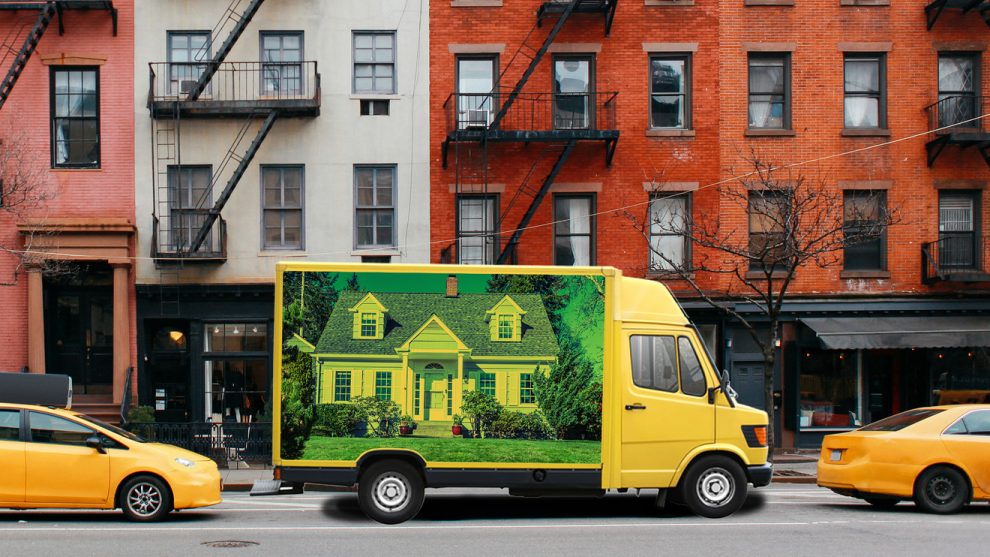
Sick of being cramped inside a small apartment where you now not only live, but work and teach your kids, too? You’re far from alone these days.
But buying a home and moving to the suburbs is far from a fool-proof decision from a financial perspective, even in an era of rock-bottom mortgage rates.
Many city dwellers have taken a newfound interest in suburban and rural living as the coronavirus pandemic has transformed our daily lives and living spaces. Sales of new and existing homes have skyrocketed in recent months thanks to a combination of pent-up demand from the spring and city residents entering the market in search of more space.
“We’ve been speculating about increasing interest in the suburbs and rural areas since the start of the pandemic,” Redfin economist Taylor Marr said in a recent report from the real-estate brokerage firm. “Now we’re seeing concrete evidence that rural and suburban neighborhoods are more attractive to homebuyers than the city, partly because working from home means commute times are no longer a major factor for some people.”
Redfin RDFN, +2.12% found that home prices are up 11.3% year-over-year in rural areas and 9.2% in the suburbs. In urban areas, meanwhile, prices are up just 6.7%.
But the price of the home and the interest rate you can get on a mortgage are just two of the financial factors that buyers need to consider before renting a U-Haul to live the suburban life. Here are five other factors to consider when calculating the cost of such a move:
Buying a home may be cheaper, but property taxes can be higher
Property taxes accounted for more than 30% of all the tax revenue that state and local governments collected from Americans in fiscal year 2017, according to the right-leaning Tax Foundation. Property taxes are the single largest form of state and local tax revenue, the think tank said.
Though property taxes can go as low as a median of $200 in some places, the five counties with the highest median property tax bills are in suburbs surrounding New York City, according to Tax Foundation data. The 2018 median bill in these counties — Bergen and Essex in New Jersey and Nassau, Rockland and Westchester in New York — exceeded $10,000.
It’s important to keep the tax burden in context, said Jared Walczak, the Tax Foundation’s vice president of state projects. “All-in suburban property costs tend to be lower than those in prosperous downtowns, but the property tax itself may be higher. This is certainly true for some of the wealthiest suburbs of cities like New York and Philadelphia, but isn’t necessarily true across the country.”
Still, he added, “even if property taxes are higher, overall taxes are lower in the suburbs. For instance, both New York and Philadelphia impose high municipal income taxes that neighboring jurisdictions lack.”
Median property tax bills in some Illinois counties and Bay Area counties of California can range between $6,000 and $7,000, according to Tax Foundation data.
A bigger living space can mean higher utilities, water and garbage bills
Be ready to potentially pay more in utilities if you are living in the suburbs with more space to heat or cool — especially if you are working from home and running fans, computers, appliances and other electronics during the work day.
Here’s an object lesson from ConEd, ED, +3.70% a utility provider for New York City and the suburban Westchester County to the north of the city.
A typical New York City customer paid a $94.25 electric bill in July, according to spokesman Allan Drury. Meanwhile, a Westchester customer paid $112.99. That’s not even a $20 difference, but the costs add up. From January to July, the typical Westchester customer paid almost $135 more for electricity alone, the ConEd data show.
It’s not a hard and fast rule that suburbanites will pay more, Drury noted. It comes down to energy usage, and someone in the city could use more power than someone in the suburbs.
There’s also the water bill and other possible expenses like fees for garbage removal. Those may or may not be included in town services. The average monthly water bill in the U.S. is around $70, according to Move.org, a website with tips on moving and listings for moving companies. Trash removal can range from $30 to $50, according to Homeadvisor.com.
City-dwellers need to remember they already pay for these services in a certain way, said Alison Bernstein, president and founder of The Suburban Jungle, a real estate firm that focuses on moves out of cities into suburbs. Client demand is up 500% year-over-year from the second and third quarter of last year compared to this one, she noted.
Water bills and garbage fees might just be wrapped up into the rent and common charges people pay in the city. Prospective buyers eyeing a particular house should ask about monthly utility costs to get a better sense of the incidental costs, Bernstein said.
Owning a home means your responsible for its maintenance and upkeep
The downside of owning your home is you will no longer have a building super or landlord to handle fixing the leaking pipes and chipped paint — or pay for it.
“The amount of money that any homeowner should budget for annual upkeep and maintenance is anywhere between 1% and 4% of the value of the home,” said Dana Menard, founder and CEO of Twin Cities Wealth Strategies, a financial advisory firm based in Maple Grove, Minn.
In other words, for a home worth $320,000, you can expect to pay between $3,200 and $12,800 a year on maintenance, Menard said.
But that can easily go much higher depending on where you live. In more expensive parts of the country, the cost of hiring people to fix your home will naturally be higher. For instance, a 2018 report from real-estate website Zillow ZG, +0.72% and services marketplace Thumbtack found that homeowners in Portland, Ore., paid $3,800 annually on average for services like house cleaning and appliance repairs. Comparatively, folks in Miami only pay $2,570 on average.
And if you choose to buy a home in a neighborhood with a homeowners’ association, you may face added costs for maintenance services such as lawn care as part of your HOA fees.
Leaving the city can mean relying more on cars and commuting
Between public transit and tightly clustered neighborhoods, you don’t need a car in many major cities. (That’s part of the allure for some who don’t want to deal with parking rules.) But in the more spread-out suburbs, life without a car could be trickier — especially if you’ve got kids in tow.
A move to the suburbs might also mean getting a second vehicle, depending on a particular family’s work schedule and lifestyle needs. People need to figure out what’s best for them, said Bernstein. “Anything can work, you just have to plan ahead and factor that into your life.”
If it means buying a car, people should realize the new and used market isn’t what it was a couple months ago, said Michelle Krebs, executive analyst at Cox Automotive, the parent company of brands including Kelley Blue Book.
Around March and April, many car makers trying to move new vehicles off the lot were offering 0% financing for the life of the loan to buyers with excellent credit.
“People grabbed those. As inventory has dwindled down, those deals have started to dry up,” Krebs said. In July, a new vehicle cost $38,378, which is up from $37,629 at the same point last year. Between supply chain woes and new social distancing protocols at automotive plants, Krebs thinks inventory will stay low for the rest of the year — and that won’t give dealers a lot of leeway to haggle.
“The normal channel for used cars has also been disrupted,” Krebs said. For example, drivers are not trading in their vehicles and lenders are giving cash-strapped drivers forbearance on loans, which means cars are not being re-possessed.
Earlier in August , the average price of a used car was $20,212, the second consecutive week where the price exceeded $20,000. The average used car price hasn’t broken the $20,000 mark in the years Krebs has been tracking the number.
More space can mean buying more furniture and décor
Owning a bigger house will eventually mean needing furniture to fill the additional rooms. And many first-time homeowners find themselves in a trap where they can’t resist buying that furniture right away.
Doing so could be a huge mistake though, Menard said. “Many people make the mistake of pulling out the credit card to take care of it quickly,” he said. Because many homeowners don’t think to budget for those impulsive purchases, they often don’t have the funds to cover the credit card balance.
Therefore, buying the fixings to spruce up your new abode with credit cards can “ultimately add an additional 25% to 50% of costs,” Menard said, once the interest rate on the credit card is factored in. Currently, the average annual percentage rate for credit cards is 16%, according to CreditCards.com.











Add Comment